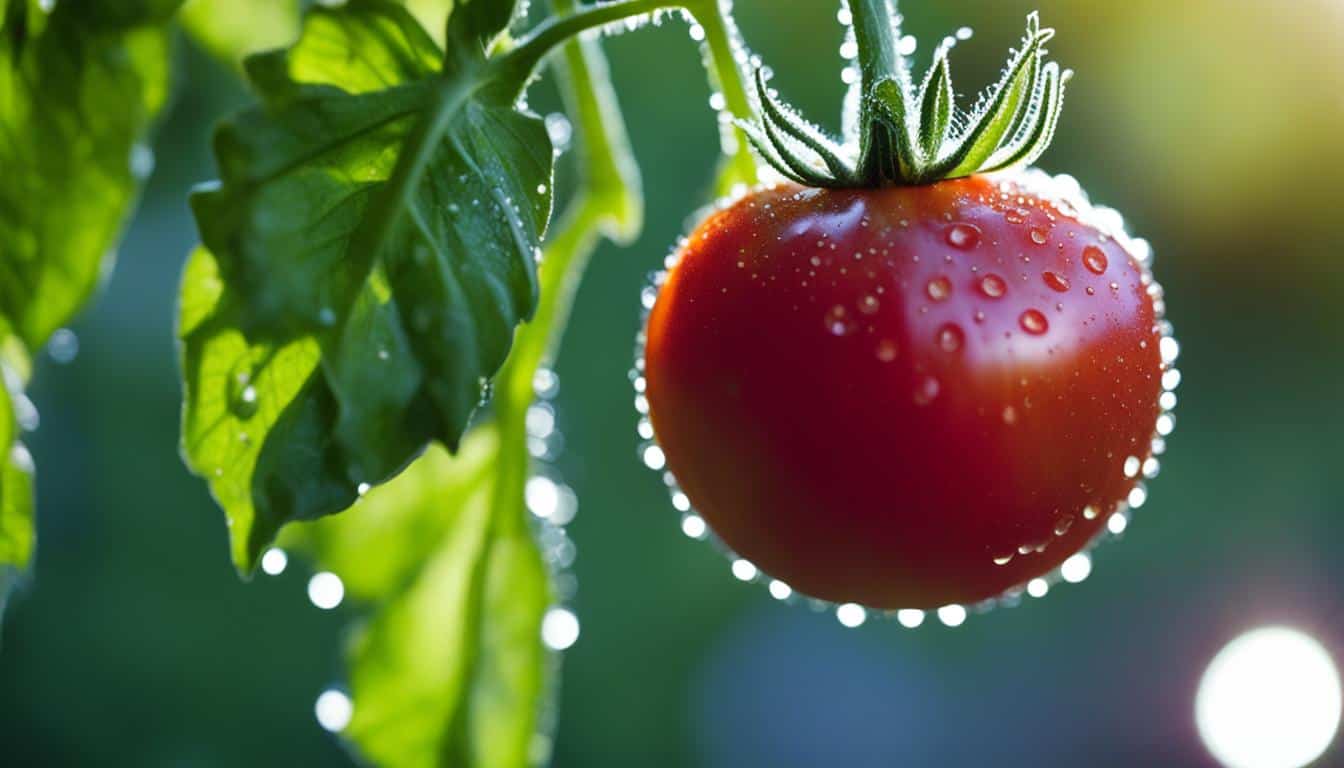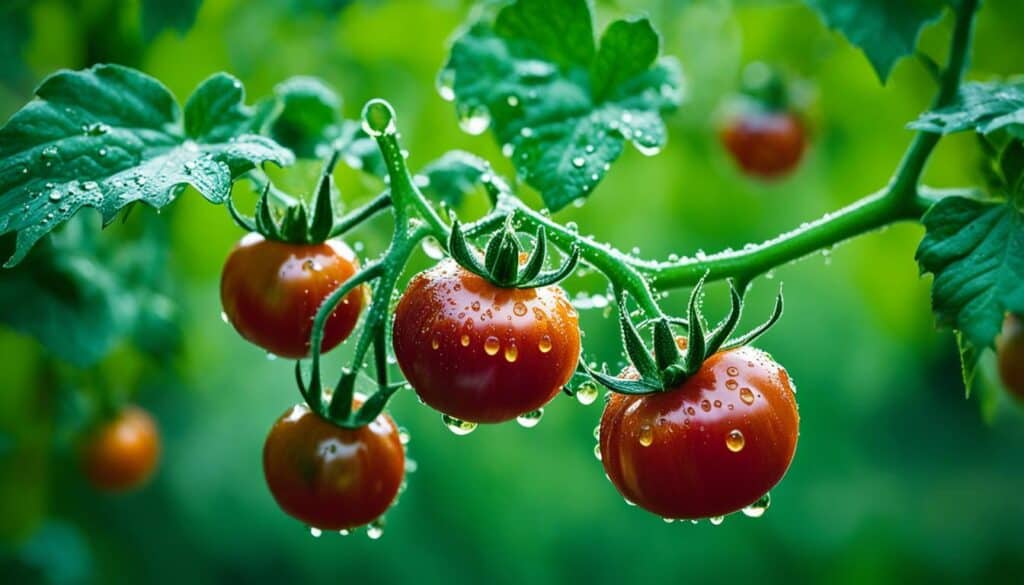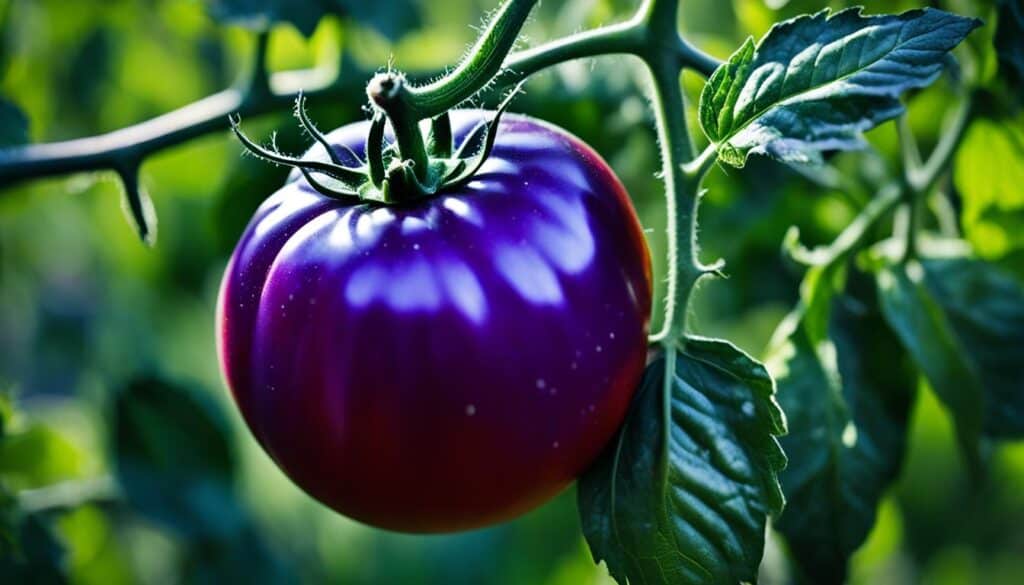Did you know that Cherokee Purple tomatoes, with their vibrant purple skin and juicy red flesh, are not only a stunning addition to your garden but also offer a flavor that is unmatched by other tomato varieties? These heirloom tomatoes have a perfect balance of sweetness and acidity, making them ideal for slicing, salads, and delicious tomato recipes. In this article, I will share some valuable gardening tips to help you successfully grow Cherokee Purple tomatoes and enjoy the bliss of these flavorful fruits.
- Cherokee Purple tomatoes have a rich flavor and vibrant appearance that sets them apart from other tomato varieties.
- These heirloom tomatoes are the perfect choice for organic gardeners, as they have been passed down through generations without genetic modification.
- When planting Cherokee Purple tomatoes, choose a sunny spot with well-drained soil and provide regular watering and support as they grow.
- Harvest Cherokee Purple tomatoes when they reach a deep purple color and savor their exceptional taste in a variety of tomato recipes.
- Growing heirloom tomatoes like Cherokee Purple can bring joy and satisfaction to any gardener, offering unique flavors and a rich history.
Why Choose Cherokee Purple Tomatoes?
Cherokee Purple tomatoes are a popular choice among gardeners for several reasons. Firstly, their flavor is unmatched – they have a perfect balance of sweetness and acidity that makes them ideal for salads, sandwiches, and sauces. Additionally, they are an heirloom variety, which means they have been passed down through generations and retain their original traits. This also means they are organically grown, as they have not been genetically modified. If you’re looking for a tomato with exceptional flavor and a rich history, Cherokee Purple is the perfect choice.
Taste the Flavorful Difference
“Cherokee Purple tomatoes offer a tantalizingly sweet and tangy flavor that is unlike any other tomato variety. Their complexity of taste infuses every bite, making them a real treat for anyone who appreciates the culinary delights of fresh produce.” – Mary Smith, Gardening Enthusiast
When it comes to flavor, Cherokee Purple tomatoes reign supreme. Their unique blend of sweetness and acidity creates a taste sensation that simply can’t be replicated by other tomato varieties. Whether you’re enjoying them fresh in a salad or cooked into a sauce, their distinct flavor profile adds depth and richness to any dish.
Furthermore, Cherokee Purple tomatoes are organically grown. This means they are free from synthetic pesticides and genetically modified organisms (GMOs). By choosing these tomatoes, you can savor their exceptional taste while supporting sustainable and environmentally friendly farming practices.
Preserving a Piece of History
“Heirloom tomatoes like Cherokee Purple are a living link to the past. They represent our agricultural heritage and the diverse flavors that have been cherished for generations.” – James Thompson, Tomato Historian
As an heirloom variety, Cherokee Purple tomatoes have a rich history that spans decades. These tomatoes have been cultivated by generations of gardeners, passed down for their outstanding qualities and unique characteristics. By growing Cherokee Purple tomatoes, you become part of this living history, preserving the legacy of a tomato variety that has stood the test of time.
So, why settle for ordinary tomatoes when you can experience the exceptional flavor and heritage of Cherokee Purple? Indulge in the blissful taste and savor the satisfaction that comes with growing your own organic, flavorful, and heirloom tomatoes.
| Why Choose Cherokee Purple Tomatoes? |
|---|
| Unmatched flavor |
| Perfect balance of sweetness and acidity |
| Ideal for salads, sandwiches, and sauces |
| Heirloom variety |
| Organically grown |
| Preserves agricultural heritage |
Planting Cherokee Purple Tomatoes
Before you embark on the journey of growing Cherokee Purple tomatoes, it’s essential to choose the perfect spot in your garden that receives ample sunlight and has well-drained soil. These tomatoes thrive in full sun, so make sure they get at least 6-8 hours of direct sunlight each day.
In order to provide your plants with the best possible start, it’s important to prepare the soil beforehand. Enhance the fertility and drainage of the soil by incorporating organic matter such as compost or aged manure. This will ensure that the tomatoes have access to the necessary nutrients for healthy growth.
When it comes time to plant the Cherokee Purple tomatoes, dig a hole that is twice the size of the tomato’s root ball. Carefully place the plant in the hole, making sure not to disturb the roots. Gently backfill the hole with soil and press it down to secure the plant. Water the tomatoes thoroughly after planting to help the roots settle and establish themselves.
Remember, the key to successful growth is providing Cherokee Purple tomatoes with the right conditions and care from the very beginning. By following these planting tips, you’ll be well on your way to a thriving tomato garden.
Caring for Cherokee Purple Tomatoes
To ensure the successful growth of your Cherokee Purple tomatoes, it’s important to provide proper care. These tomatoes require regular watering, about 1-2 inches per week. Water deeply, allowing the soil to dry out slightly between waterings. Mulching around the plants can help conserve moisture and suppress weeds. Additionally, it’s important to support the plants as they grow by using stakes or cages to prevent them from bending or breaking. Pruning is not necessary for Cherokee Purple tomatoes, but removing any suckers that form in the leaf axils can help focus energy on fruit production.
Proper Watering Techniques
Cherokee Purple tomatoes thrive on consistent moisture. Watering deeply once or twice a week, depending on weather conditions, ensures that the plants receive enough water without oversaturating the soil. Monitor the moisture levels by checking the soil with your finger. If it feels dry an inch below the surface, it’s time to water. Be mindful not to overwater, as this can lead to root rot. Remember, consistent moisture is key for healthy growth.
Mulching and Weed Control
Applying a layer of organic mulch around your Cherokee Purple tomato plants has multiple benefits. Mulching helps to retain moisture in the soil, preventing it from evaporating quickly. It also acts as a natural weed barrier, reducing the competition for nutrients and water. Organic mulch options include straw, grass clippings, or compost. Apply a 2-3 inch layer around the base of the plants, taking care not to cover the stems or leaves.
Providing Support
As Cherokee Purple tomatoes grow, their branches may become heavy with fruit, increasing the risk of bending or breaking. To prevent this, it’s essential to provide support in the form of stakes or cages. Stakes can be inserted into the ground near the plants, and the tomato stems can be loosely tied to them using soft twine or plant ties. Alternatively, tomato cages can be placed around the plants at the time of planting. The cages provide a structured support system that holds the plants upright, allowing the fruit to grow without interference.
Pruning for Enhanced Fruit Production
While pruning is not necessary for Cherokee Purple tomatoes, removing suckers that form in the leaf axils can help improve fruit production. Suckers are small side shoots that develop between the main stem and the leaf stems. By removing these suckers, the plant can direct its energy toward developing larger, more abundant fruit. Use clean, sharp pruners or garden shears to trim off the suckers. Be careful not to remove too much foliage, as the leaves play a vital role in photosynthesis.
| Caring for Cherokee Purple Tomatoes | |
|---|---|
| Watering | About 1-2 inches per week |
| Mulching | Around the plants to conserve moisture and suppress weeds |
| Support | Stakes or cages to prevent bending or breaking |
| Pruning | Remove suckers to focus energy on fruit production |
Harvesting Cherokee Purple Tomatoes
After patiently nurturing your Cherokee Purple tomatoes, the time has come to reap the sweet rewards of your hard work. Harvesting these delectable tomatoes is a truly gratifying experience. Let me guide you through the process of harvesting these vibrant and flavorful fruits.
Cherokee Purple tomatoes are generally ready to be plucked from the vine 75-85 days after planting. When the tomatoes display a uniform deep purple color from top to bottom, it’s a sure sign that they are ripe and ready for picking. The rich hues of these tomatoes are a feast for the eyes and a prelude to the burst of flavor that awaits your palate.
To maintain the integrity of the tomatoes, it’s important to handle them with care during the harvest. Gently hold the stem just above the fruit and twist it away from the vine. Alternatively, you can use clean pruning shears or a sharp knife to cut the stem. This minimizes the risk of damaging the tomatoes and ensures their optimal freshness.
Once you have gathered your bountiful harvest of Cherokee Purple tomatoes, it’s time to indulge in their sensational taste and texture. These tomatoes are renowned for their succulent juiciness and robust flavor, which make them an ideal choice for slicing. The dense, meaty flesh of Cherokee Purple tomatoes holds its shape perfectly when cut into thick, juicy slices.
Whether adding them to vibrant salads, crafting mouthwatering sandwiches, or embellishing classic burger recipes, Cherokee Purple tomatoes are a culinary delight. Their complex flavors and juicy texture elevate every dish they grace, creating a symphony of taste sensations.
| Best use: | Slicing |
| Harvest time: | 75-85 days after planting |
| Harvest method: | – Twist the stem just above the fruit – Cut the stem with clean pruning shears or a sharp knife |
| Characteristics: | – Uniform deep purple color – Succulent and juicy texture – Rich and robust flavor |
So, go ahead and savor the extraordinary taste of your freshly harvested Cherokee Purple tomatoes. Their vibrant color, exceptional flavor, and juicy flesh are a testament to your gardening prowess. Enjoy the fruits of your labor and relish the unique experience of growing and indulging in these remarkable tomatoes.
Tomato Recipes with Cherokee Purple Tomatoes
Now that you have a delicious supply of Cherokee Purple tomatoes, it’s time to explore some tasty recipes. These flavorful tomatoes are perfect for a variety of dishes, adding a unique twist to your meals. Let’s dive into some creative ideas:
1. Caprese Salad:
Try this classic Italian dish by combining fresh Cherokee Purple tomatoes with creamy mozzarella cheese, fragrant basil leaves, and a drizzle of balsamic glaze. The vibrant colors and flavors will make this appetizer or side dish a crowd favorite.
2. Spaghetti with Fresh Tomato Sauce:
Elevate your pasta night by preparing a simple and delicious tomato sauce using ripe Cherokee Purple tomatoes. Saute garlic and onions in olive oil, add diced tomatoes, and simmer until the flavors meld together. Toss the sauce with al dente spaghetti for a satisfying and flavorful meal.
3. Tomato Bruschetta:
Showcase the delightful flavor of Cherokee Purple tomatoes by making tomato bruschetta. Toast slices of crusty bread, rub them with garlic, and top with diced tomatoes, fresh basil, and a sprinkle of salt. This appetizer is perfect for summer gatherings or as a quick snack.
These are just a few ideas to get you started. Feel free to experiment and create your own recipes using the versatile flavor of Cherokee Purple tomatoes. Whether you’re making sandwiches, salsas, or soups, these tomatoes will bring an extra burst of flavor to any dish.
The Joy of Growing Heirloom Tomatoes
Growing heirloom tomatoes, like Cherokee Purple, brings me immense joy and satisfaction as a gardener. These unique tomato varieties are known for their vibrant colors, exceptional flavors, and rich history. Each time I cultivate these plants and witness their growth, I can’t help but appreciate the heritage behind each fruit. Heirloom tomatoes offer a diverse range of flavors and textures, allowing me to savor the true essence of a tomato.
Whether you’re a seasoned gardener or just starting out, growing heirloom tomatoes is a rewarding experience. Their beauty, flavor, and historical significance make them stand out in any garden. As I nurture these plants, I feel a deep connection to the past and the generations of gardeners who have cultivated these treasured tomato varieties before me.
Heirloom tomatoes offer a wide range of colors, from deep purples to vibrant yellows and oranges. Each unique hue brings a touch of elegance and visual appeal to my garden. As the tomatoes ripen and display their distinct colors, it’s a reminder of the incredible diversity found within this tomato variety.
The flavors of heirloom tomatoes are simply unmatched. From bold and tangy to sweet and juicy, each variety offers a taste experience like no other. The complex flavors of heirloom tomatoes add depth to my culinary creations and elevate simple dishes to new heights.
“Growing heirloom tomatoes allows me to preserve these treasured varieties, keeping their legacy alive in my garden and on my plate.”
Gardening tips for heirloom tomatoes include selecting healthy seedlings or seeds from reputable sources, providing them with ample sunlight and well-drained soil, and regular watering to ensure their optimal growth and fruit production. These vines may need staking or trellising to support their abundant crop, and occasional pruning can help maintain their vigor.
With the wide variety of heirloom tomatoes available, I enjoy experimenting with different shapes, sizes, and flavors in my recipes. From classic tomato salads and salsas to delicious tomato tarts and sauces, these tomatoes add a special touch to any dish.
Experience the joy of growing heirloom tomatoes and discover the beauty, flavors, and history they bring to your garden. Whether you enjoy gardening as a hobby or as a way to connect with nature, heirloom tomatoes offer a rewarding and fulfilling experience that is truly unique.
Tips for Successful Tomato Gardening
Tomato gardening can be a rewarding endeavor, but it requires some essential tips to ensure success. Firstly, choose the right tomato variety for your garden and culinary preferences. Consider factors such as flavor, size, and disease resistance.
When selecting a tomato variety, think about the flavor profile you desire. Are you looking for a sweet and juicy tomato or a tangy and acidic one? Some popular flavorful tomato varieties include Cherokee Purple, Brandywine, and San Marzano.
“I’ve found that Cherokee Purple tomatoes have a perfect balance of sweetness and acidity, making them an excellent choice for salads and sandwiches,” says renowned gardener and organic enthusiast, Emily Green. “Their rich and distinct flavor adds a delicious twist to any dish.”
Aside from flavor, consider the size of the tomato. Do you prefer large slicing tomatoes or smaller cherry tomatoes? Keep in mind that larger varieties may require more space and support in the garden.
Disease resistance is another crucial factor to consider. Some tomato varieties are naturally more resistant to common diseases, such as tomato blight or powdery mildew. By choosing disease-resistant varieties, you can minimize the risk of losing your precious tomato plants to common ailments.
Additionally, provide your tomato plants with proper nutrition by using organic fertilizers and compost. Organic tomato gardening is not only better for the environment, but it also helps produce healthier and more flavorful fruits. Organic fertilizers and compost provide essential nutrients to the soil, promoting vigorous growth and strong plant health.
Pruning your tomato plants is another essential gardening tip. By removing the “suckers,” or the small branches that form in the leaf axils, you can redirect energy towards fruit production and improve airflow, reducing the risk of diseases.
“Pruning is a key practice for ensuring a bountiful tomato harvest,”
says Emily Green. “By removing the suckers, you create a more focused and productive plant.”
Lastly, keep an eye out for pests and take necessary measures to protect your plants. Common tomato pests include aphids, caterpillars, and tomato hornworms. Use organic pest control methods, such as companion planting or introducing beneficial insects like ladybugs or lacewings, to keep pests at bay.
“By practicing regular pest monitoring and using organic pest control methods, you can ensure the health and productivity of your tomato plants,” advises Emily Green.
By following these tips, you can enjoy a fruitful tomato garden and savor the flavors of homegrown tomatoes.
Exploring Tomato Varieties
Tomatoes come in a wide variety of shapes, sizes, and flavors. From tiny cherry tomatoes to large beefsteak tomatoes, there is a tomato for every taste. Heirloom tomatoes, like Cherokee Purple, offer unique flavors and rich histories.
Consider exploring different tomato varieties in your garden to experience a diverse range of tastes and textures. Whether you prefer sweet, tangy, or savory tomatoes, there is a variety out there that will delight your taste buds.
Popular Tomato Varieties:
| Variety | Flavor Profile | Best Uses |
|---|---|---|
| Cherokee Purple | Rich and complex | Slicing and salads |
| Sungold | Sweet and tangy | Snacking and salads |
| Brandywine | Sweet and juicy | Slicing and sandwiches |
| Roma | Meaty and low in acidity | Sauces and canning |
Exploring diverse tomato varieties in your garden not only adds excitement to your meals but also allows you to appreciate the range of flavors and textures that tomatoes have to offer. So go ahead and plant different varieties to create a tomato paradise in your own backyard!
Benefits of Organic Tomatoes
Organic tomatoes, like the flavorful Cherokee Purple variety, offer numerous benefits for both the environment and your health. Unlike conventionally grown tomatoes, organic tomatoes are cultivated without the use of synthetic pesticides and fertilizers, making them a healthier choice. By opting for organic tomatoes, you can enjoy the natural goodness of these vibrant fruits while supporting sustainable farming practices.
Increase in Flavor and Vibrancy
One of the significant advantages of organic tomatoes is their richer flavors and more vibrant colors compared to conventionally grown counterparts. The absence of synthetic chemicals allows the natural flavors of the tomato to shine through, resulting in a more pronounced and enjoyable taste. The vibrant hues of organic tomatoes not only enhance their visual appeal but also indicate higher nutrient content.
“Organic tomatoes are a testament to the fact that nature’s way of growing food results in superior taste and quality. Their rich flavor and vibrant colors are a feast for the senses.”
Environmental Sustainability
By choosing organic tomatoes, you are actively contributing to the preservation of the environment. Organic farming practices prioritize the use of natural resources and promote biodiversity. They minimize soil erosion, protect water quality, and support pollinators and beneficial insects. By supporting organic agriculture, you are helping to sustain ecosystems and reduce the impact of agricultural activities on the planet.
Health Benefits
Organic tomatoes offer several health benefits. They are free from synthetic pesticide residues, which can be harmful when consumed in large quantities. Choosing organic tomatoes reduces your exposure to these potentially harmful chemicals. Moreover, organic tomatoes are also an excellent source of antioxidants, vitamins, and minerals, which are essential for maintaining good health.
| Benefits of Organic Tomatoes | Conventionally Grown Tomatoes |
|---|---|
| Richer flavors and vibrant colors | May have muted flavors and less vibrant colors due to pesticide use |
| Environmentally sustainable | Conventional farming practices may contribute to soil degradation and water pollution |
| Reduced exposure to synthetic chemicals | Possible exposure to synthetic pesticides and fertilizers |
| Higher in antioxidants, vitamins, and minerals | May contain lower nutrient levels due to intensive farming methods |
Choosing organic tomatoes not only benefits the environment but also promotes your well-being, allowing you to enjoy the pure, unadulterated flavors of these delicious fruits.
The Versatility of Tomatoes in the Kitchen
Tomatoes are incredibly versatile in the kitchen and can be used in a wide variety of recipes. From salads to sauces, soups to sandwiches, tomatoes add depth and flavor to many dishes.
Experiment with different cooking methods to fully explore the culinary possibilities of tomatoes. Whether you roast them to bring out their natural sweetness, blend them into a smooth marinara sauce, or slice them for a fresh caprese salad, tomatoes can elevate your home-cooked meals to new heights.
Heirloom tomatoes, such as Cherokee Purple, add an extra layer of complexity to recipes with their unique flavors. Their vibrant colors and rich flavors make them a standout ingredient in any dish.
Tomato Recipes
Here are a few delicious tomato recipes to get you started:
- Caprese Salad: Combine sliced Cherokee Purple tomatoes with fresh mozzarella, basil leaves, and a drizzle of balsamic glaze. It’s a simple yet elegant appetizer or side dish.
- Tomato Bruschetta: Toast slices of crusty bread and top them with diced tomatoes, garlic, basil, and a splash of olive oil. It’s a flavorful and refreshing snack.
- Tomato Gazpacho: Blend ripe tomatoes with cucumbers, bell peppers, onion, garlic, and a touch of olive oil to create a refreshing cold soup.
These are just a few examples, but the possibilities are endless. Get creative in the kitchen and explore different tomato recipes to enjoy the full range of flavors and textures that tomatoes have to offer.
Expert Tip
“When using flavorful heirloom tomatoes like Cherokee Purple, it’s best to let their natural taste shine. Keep the seasoning minimal to truly appreciate their unique flavors.” – Chef Sarah Thompson
So go ahead and make the most of the versatile tomato in your culinary adventures. From appetizers to main courses, these flavorful heirloom tomatoes will add a delicious twist to your dishes, making them a feast for both the eyes and the taste buds.
Conclusion
Growing Cherokee Purple tomatoes can be a truly rewarding experience for any gardener. The exceptional flavor, unique traits, and rich history of these tomatoes make them a prized addition to any garden. By following the gardening tips provided and exploring the culinary possibilities of these flavorful tomatoes, you can embark on a delicious journey and enjoy the bliss of growing and savoring Cherokee Purple tomatoes.
With their purple skin and juicy red interior, Cherokee Purple tomatoes are a feast for the senses. Their perfect balance of sweetness and acidity makes them ideal for a variety of dishes, from salads to sauces. As an heirloom variety, these tomatoes have been passed down through generations, preserving their original traits and ensuring they are organically grown without any genetic modifications.
By choosing to grow Cherokee Purple tomatoes, you not only indulge in their remarkable flavor but also connect with their rich heritage. So, why not start planting these delightful tomatoes in your garden? With the gardening tips provided in this article, you have all the information you need to successfully grow and enjoy the bountiful harvest of flavorful Cherokee Purple tomatoes.










Leave a Reply